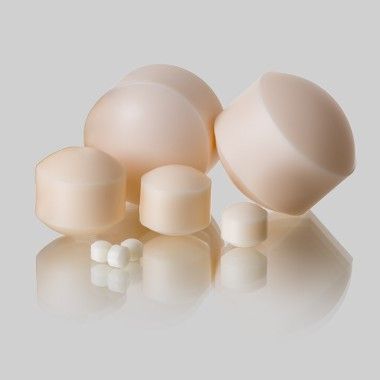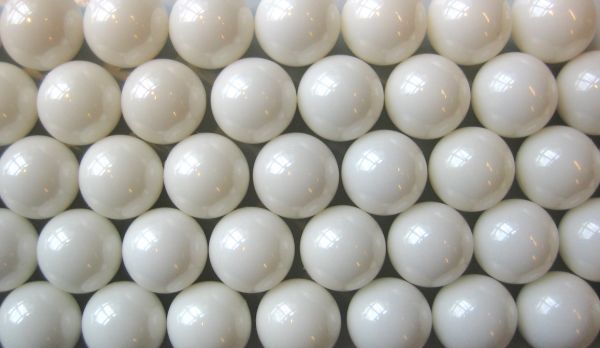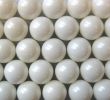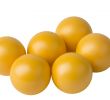Ceramic grinding balls
Grinding balls are small spheres (although they are not usually perfectly spherical) that can be used for attrition and mixing of products such as powders. Our standard product range includes balls made of alumina and zirconia, as both of these technical ceramics offer ideal purity and density for grinding hard products. The diameter of our industrial balls ranges from 5 mm to 30 mm. These balls are the ones used in ball mills, which are efficient devices for powder attrition by impact and friction.

Grinding balls from our standard product range
The grinding balls we offer are made of alumina or zirconia. Since they are not precision balls, their shape is not perfectly spherical. Perfect sphericity is not necessary for attrition and mixing of products. These balls are therefore generally cylindrical with hemispherical bases. The diameter of the base and the height are however identical to ensure a minimum spherical aspect allowing the industrial balls to roll in all directions.
The diameter of our Kyocera DEGUSSIT AL23 alumina balls can vary from 5 mm to 30 mm with possible sizes ranging from 5 to 5 mm. Our balls are sold per kilogram. As an indication, one kilogram corresponds to 8325 balls of the smallest size (5 mm diameter) against only 15 of the largest size (30 mm).
See our standard catalog products (please contact us for zirconia grinding balls)
Why choose alumina or zirconia for grinding balls?
We offer industrial grinding balls made of Kyocera alumina (DEGUSSIT AL23 or F99.7 which are 99.7% pure alumina) and zirconia. Both of these technical ceramics are quite dense, which makes them ideal for grinding the vast majority of products. The density of alumina is close to 4 g/cm3, that of zirconia is 5.8 g/cm3.
In addition to this density which is an important factor in the manufacture of grinding balls, these two ceramics offer remarkable thermal properties. Indeed, they are both resistant to thermal shocks and very high temperatures: zirconia is resistant to temperatures above 1000 °C.
What are grinding balls and ball mills used for?
Because grinding balls are not perfectly spherical, they are not suitable for high-precision applications. For non-return valves or high-precision ball bearings, it is better to use precision balls whose sphericity will better meet the expectations.
However, grinding balls are perfectly suited to the attrition of materials and powders. This is called a ball mill or grinding machine: the balls and the product to be ground are placed in a container, which is set in motion, in rotation. The attrition is then achieved by a mechanical grinding mechanism due to the friction of the balls on the product and the wall.
In the same way, ceramic grinding balls can be used for mixing: the operation is the same as for attrition, but this time several products are placed in the mixer rather than one. The rolling motion of the balls will allow the different products to be perfectly mixed.
Ceramic ball mills are effective tools for attrition and crushing of fibrous or hard materials. They can be used to grind dry, wet and even cryogenically treated materials. They efficiently and quickly grind and homogenize volumes of products by impact and friction. The particles obtained as a result of this crushing process are remarkably fine, especially in small quantities.









